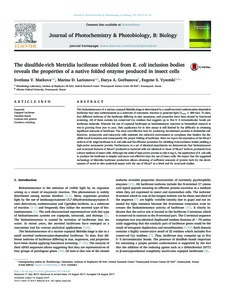Показать сокращенную информацию
The disulfide-rich Metridia luciferase refolded from E. coli inclusion bodies reveals the properties of a native folded enzyme produced in insect cells
| Автор | Svetlana V. Markova | |
| Автор | Marina D. Larionova | |
| Автор | Eugene S. Vysotski | |
| Дата внесения | 2018-02-07T07:24:19Z | |
| Дата, когда ресурс стал доступен | 2018-02-07T07:24:19Z | |
| Дата публикации | 2017-08 | |
| Библиографическое описание | Svetlana V. Markova. The disulfide-rich Metridia luciferase refolded from E. coli inclusion bodies reveals the properties of a native folded enzyme produced in insect cells [Текст] / Svetlana V. Markova, Marina D. Larionova, Eugene S. Vysotski // JOURNAL OF PHOTOCHEMISTRY AND PHOTOBIOLOGY B-BIOLOGY: Biology. — 2017. — Т. 175. — С. 51-57 | |
| ISSN | 10111344 | |
| URI (для ссылок/цитирований) | http://www.sciencedirect.com/science/article/pii/S1011134417309302?via%3Dihub | |
| URI (для ссылок/цитирований) | https://elib.sfu-kras.ru/handle/2311/69558 | |
| Описание | Текст статьи не публикуется в открытом доступе в соответствии с политикой журнала. | |
| Аннотация | The bioluminescence of a marine copepod Metridia longa is determined by a small secreted coelenterazine-dependent luciferase that uses coelenterazine as a substrate of enzymatic reaction to generate light (λmax = 480 nm). To date, four different isoforms of the luciferase differing in size, sequences, and properties have been cloned by functional screening. All of them contain ten conserved Cys residues that suggests up to five SS intramolecular bonds per luciferase molecule. Whereas the use of copepod luciferases as bioluminescent reporters in biomedical research in vivo is growing from year to year, their application for in vitro assays is still limited by the difficulty in obtaining significant amounts of luciferase. The most cost-effective host for producing recombinant proteins is Escherichia coli. However, prokaryotic and eukaryotic cells maintain the reductive environment in cytoplasm that hinders the disulfide bond formation and consequently the proper folding of luciferase. Here we report the expression of the MLuc7 isoform of M. longa luciferase in E. coli cells and the efficient procedure for refolding from inclusion bodies yielding a high-active monomeric protein. Furthermore, in a set of identical experiments we demonstrate that bioluminescent and structural features of MLuc7 produced in bacterial cells are identical to those of MLuc7 isoform produced from culture medium of insect cells. Although the yield of high-purity protein is only 6 mg/L, the application of E. coli cells to produce the luciferase is simpler and more cost-effective than the use of insect cells. We expect that the suggested technology of Metridia luciferase production allows obtaining of sufficient amounts of protein both for the development of novel in vitro analytical assays with the use of MLuc7 as a label and for structural studies. | |
| Тема | Copepod luciferase | |
| Тема | Disulfide bonds | |
| Тема | Cysteine-rich protein | |
| Тема | Oxidative refolding | |
| Название | The disulfide-rich Metridia luciferase refolded from E. coli inclusion bodies reveals the properties of a native folded enzyme produced in insect cells | |
| Тип | Journal Article | |
| Тип | Published Journal Article | |
| Страницы | 51-57 | |
| ГРНТИ | 34.17.15 | |
| Дата обновления | 2018-02-07T07:24:19Z | |
| DOI | 10.1016/j.jphotobiol.2017.08.024 | |
| Институт | Институт фундаментальной биологии и биотехнологии | |
| Подразделение | Базовая кафедра биотехнологии | |
| Журнал | JOURNAL OF PHOTOCHEMISTRY AND PHOTOBIOLOGY B-BIOLOGY | |
| Квартиль журнала в Scopus | Q2 | |
| Квартиль журнала в Web of Science | Q2 |

